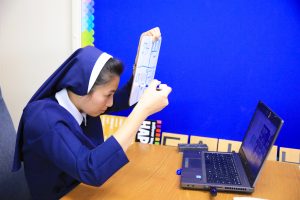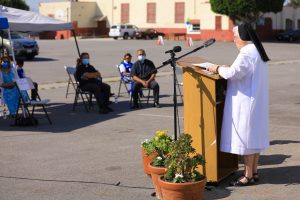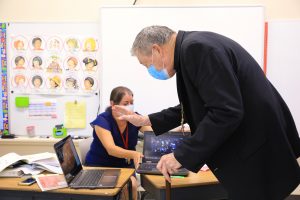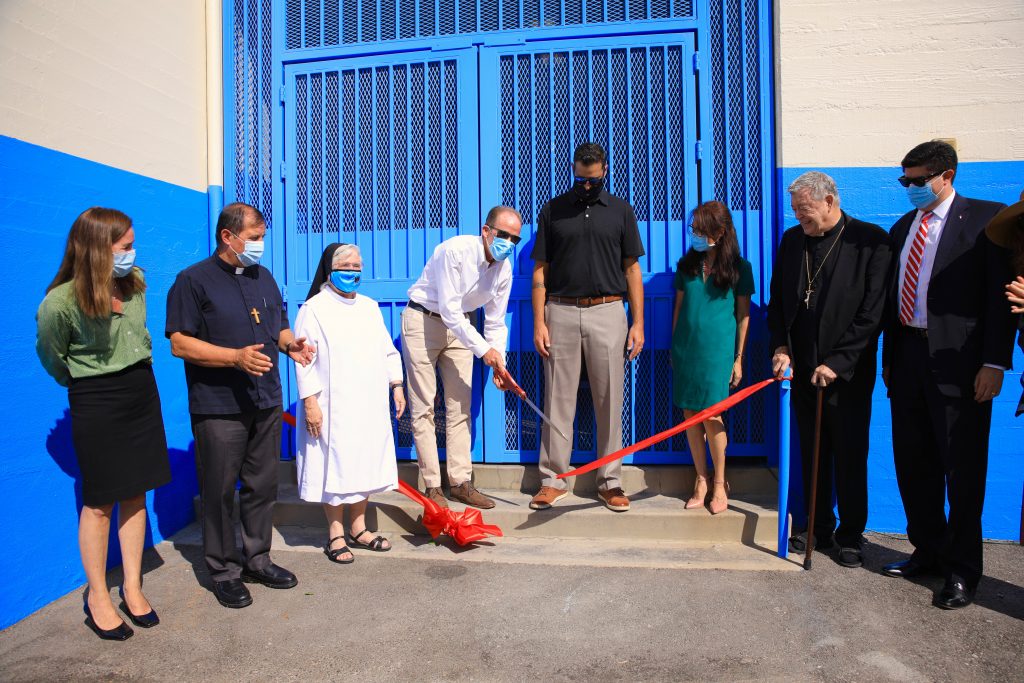St. Frances Xavier Cabrini School in South Los Angeles celebrated the culmination of a $1.5 million campus renovation with a socially distanced ribbon-cutting ceremony on Sept. 30, complete with a blessing and dedication by regional Auxiliary Bishop Edward Clark.
The upgrade for the school, built in 1951, goes far beyond paint and landscaping. For a new air-conditioning system, an overhaul of the electrical system was necessary. Classrooms not only have new flooring but emergency windows in each door. The four student restrooms were enhanced to be more efficient as well as safer. Teachers also have an updated lounge and restroom, as well as a new public-address system.
The renovation work began last March, just as schools were transitioning to distance learning amid the coronavirus shutdown.

The project is the latest success story in a long-standing commitment by Shea Family Charities to Catholic schools.
Dorothy Shea was one of the founding members of the Vision of Hope board, which started in 1995 by Dominican Sisters who wereco ncerned about the trend of Catholic schools closing because of lack of funding and attendance. The Dominican Sisters' Vision Of Hope focused on eight elementary schools in the state, three in the San Francisco Bay area, and five in Los Angeles. In addition to St. Frances X. Cabrini, it also serves nearby St. Michael’s School in South LA, Sacred Heart School in Lincoln Heights, St. Ignatius School in Highland Park and St. Teresita School in Boyle Heights.
Vision of Hope board member Sister Georgette Coulombe, OP, said its non-profit has committed more than $16 million in donations to Catholic school projects over the last 25 years, starting with tuition assistance and moving to other programs.

“On behalf of the Dominican Sisters and Vision of Hope, I wish to express gratitude for the gifts our students have received,” Sister Georgette said during the ceremony. “May the Shea family continue to teach us that God calls us to help each other. … They are true stewards of God’s love.
“And may (pastor) Father Juan Bosco [Jimenez], his staff, the faculty, and the current school board be reenergized by this beautiful building to spread the word of God and work tirelessly for the good of the students who use this facility for many years to come.”
Carmen Orinoco-Hart, the principal at St. Frances Xavier Cabrini for the last 11 years, said the repeated visits and hands-on supervision by Shea Family Charities Executive Director Dan O’Melveny were what made this project happen in time for the new school year.

“It is really so humbling to see the Shea family share all these blessings with the inner-city schools as well as the entire community,” said Orinoco-Hart. “Several parents have told me they want to register their children when in-person instruction comes back. I know our children’s eyes will light up when they see this transformation. They are already writing thank-you notes to the Shea family.”
Lynne Hook, president of the St. Frances Xavier Cabrini Development Board, said the next Shea-endorsed project the school could soon see is a $1.4 million turf soccer field to be accessible by surrounding schools and community.
Bishop Clark toured the facility and met with teachers who were conducting remote learning, stopping to bless each group of students he saw on the computer screens.
Paul Escala, superintendent of Catholic Schools in the Archdiocese of Los Angeles, said during the ceremony that some of the 230 currently enrolled students would be able to see the upgraded facility fairly soon. He noted that his department has already begun the state waiver process to open classrooms to students in transitional kindergarten through second grade “so the most needy can make a safe return to instruction.”

